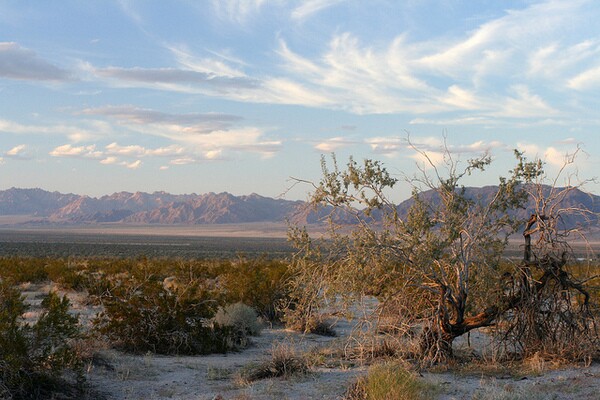Obama Administration Fast-Tracks More Renewable Energy Projects

Looking from Desert Center northward across the Desert Harvest solar site. | Photo: Chris Clarke
The Obama administration announced today that it is placing seven renewable energy projects on its so-called "fast track" for development, including two solar projects in eastern Riverside County and two within spitting distance of the state line, in Arizona and Nevada.
The California projects, enXco's 150 megawatt Desert Harvest project west of Desert Center and NextEra's 750-megawatt McCoy Solar Energy, would both use photovoltaic technology on more than 6,000 total acres of public lands.
The administration also placed First Solar's Silver State South and Solar Reserve's Quartzsite projects on the fast track list, as well as three other solar and wind projects in Nevada, Arizona, and Wyoming. The seven projects have been fast-tracked under the administration's "We Can't Wait" initiative, a campaign-year program designed to heighten criticisms of Republican party officials on their lackluster job creation and economic development performance.
"As part of President Obama's all-of-the-above strategy to expand domestic energy production and strengthen the economy, we are working to advance smart development of renewable energy on our public lands," Interior Secretary Ken Salazar said in a White House press release. "These seven proposed solar and wind projects have great potential to grow our nation's energy independence, drive job creation, and power economies across the west."
A "fast-tracked" project is one that is targeted for expedited federal review and permitting. The two California projects have been slated for federal review and near-inevitable approval by December.
The Desert Harvest project would occupy 1,200 acres in the Chuckwalla Valley, due south of First Solar's Desert Sunlight PV project now under construction. NextEra's McCoy project would occupy 7,700 acres north of the Blythe Airport, on the eastern alluvial fan of the McCoy Mountains. Both have been working their way through the environmental assessment process: the comment period on McCoy's Draft Environmental Impact Statement is open until August 23.
It will be interesting to see how NextEra's recent experience just west on Interstate 10 affects the McCoy project. As more information is released on the devastating flood on the company's Genesis Solar Project site, it looks as though the company may have incurred hundreds of millions of dollars worth of damage, including broken mirrors and access roads that will have to be replaced. If today's announcement can be viewed as a vote of confidence in NextEra by the Obama administration, it remains to be seen whether NextEra's potential investors will feel the same way. (Update: NextEra says we're way offin that damage assessment.)
Interestingly, FirstSolar's Silver State South project in the Ivanpah Valley may well be the venue for flood news in the future, having been sited on an alluvial fan at the mouth of a slot canyon in the Lucy Gray Mountains that drains about 25 square miles of desert. The plant's design includes flood control channels, which are almost certain to be completely ignored by a flash flood sometime in the next decade or so. Solar power developers get many things right, but the lesson that desert water does what it wants to seems to be taking some time to soak in.
ReWire is dedicated to covering renewable energy in California. Keep in touch by liking us on Facebook, and help shape our editorial direction by taking this quick survey here.


